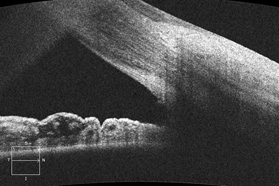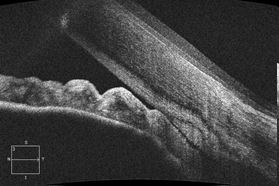Optical Coherence Tomography (OCT) is a recent advancement in imaging technique that allows capturing of cross-sectional images from live tissue at near microscopic resolution. Due to the unique properties of many transparent tissues in the eye, the OCT has many applications in Ophthalmology. The use of OCT has now become the standard of care in the diagnosis and treatment of many retinal diseases (including age related macular degeneration, diabetic retinopathy) and glaucoma.
At Applecross Eye Clinic, we are equipped with a high-resolution ‘spectral-domain’ OCT scan to achieve optimal diagnosis and treatment of various eye conditions. Below are examples of what an OCT of the eye looks like.
Application in retinal diseases:

Normal OCT image of the macula.

‘Wet’ macular degeneration image.
*Note the ‘wet’ macular degeneration image and the disruption of various layers within the retina and the presence of dark ‘cystic spaces’ which represent collection of fluid within and under the retina.
Figure 1

Application in glaucoma:
OCT allows accurate measurement of the optic disc and surrounding nerve fibre thickness which is very useful in diagnosis and monitoring of glaucoma.
View a printout from an OCT scan result of a patient here (figure 1). The patient developed advanced glaucoma in the right eye from a condition called pseudoexfoliation syndrome. The left eye is normal. Note, the ‘RNFL deviation map’ shows area of nerve fibre layer thinning highlighted in red.
An OCT scan can also help with assessing the risk of developing acute glaucoma as well by cross-sectional imaging of the ‘angle’ where Aqueous humour fluid is drained out of the eye. Below is a comparison of someone with normal angle (on the left) and a patient at high risk of acute ‘angle-closure’ glaucoma. For more information on angle closure glaucoma please click here.

Large gap where fluid can easily drain out of the eye.

Very narrow gap for fluid to drain. Sudden complete blockage of fluid flow will lead to acute glaucoma.
In Summary, use of the OCT scanning technology has now become an integral part of our day-to-day clinical decision-making in Ophthalmology and is critical in the diagnosis and treatment of many eye diseases. Our clinic offers high-resolution OCT scanning to ensure that we can give the best care for your eyes.
